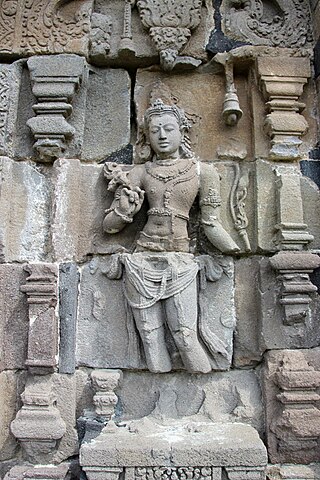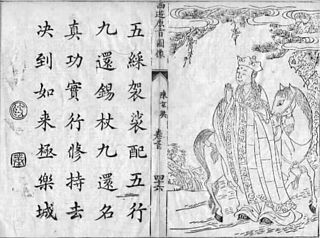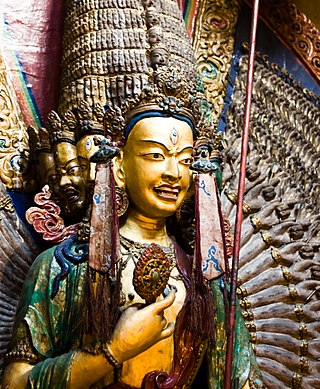
In Buddhism, a bodhisattva or bodhisatva is a person who is on the path towards bodhi ('awakening') or Buddhahood.

Guanyin is a common Chinese name of the bodhisattva associated with compassion known as Avalokiteśvara. Guanyin is short for Guanshiyin, which means "[The One Who] Perceives the Sounds of the World". Due to sociogeographical factors, Guanyin can be historically depicted as genderless or adorning an androgynous apprentice. On the 19th day of the sixth lunar month, Guanyin's attainment of Buddhahood is celebrated. Guanyin has been incorporated in other religions, including Taoism and Chinese folk religion.

Sun Wukong, also known as the Monkey King, is a literary and religious figure best known as one of the main characters in the 16th-century Chinese novel Journey to the West. In the novel, Sun Wukong is a monkey born from a stone who acquires supernatural powers through Taoist practices. After rebelling against heaven, he is imprisoned under a mountain by the Buddha. Five hundred years later, he accompanies the monk Tang Sanzang riding on the White Dragon Horse and two other disciples, Zhu Bajie and Sha Wujing, on a journey to obtain Buddhist sutras, known as the West or Western Paradise, where Buddha and his followers dwell.

Tang Sanzang is a Buddhist monk and pilgrim who is a central character in the 16th century novel Journey to the West by Wu Cheng'en. Tang Sanzang is based on the historical Tang dynasty monk Xuanzang.

In Buddhism, Avalokiteśvara, also known as Lokeśvara and Chenrezig, is a tenth-level bodhisattva associated with great compassion (mahakaruṇā). He is often associated with Amitabha Buddha. Avalokiteśvara has numerous manifestations and is depicted in various forms and styles. In some texts, he is even considered to be the source of all Hindu deities.

Tibetans are an East Asian ethnic group native to Tibet. Their current population is estimated to be around 7.7 million. In addition to the majority living in the Tibet Autonomous Region of China, significant numbers of Tibetans live in the Chinese provinces of Gansu, Qinghai, Sichuan, and Yunnan, as well as in Bhutan, the India, and Nepal.

Sukhavati is the pure land of the Buddha Amitābha in Mahayana Buddhism. Sukhavati is also called the Land of Bliss or Western Pure Land and is the most well-known of the Mahayana Buddhist pure lands due to the popularity of Pure Land Buddhism in East Asia.

The Potala Palace is a dzong fortress in Lhasa, capital of the Tibet Autonomous Region in China. It was the winter palace of the Dalai Lamas from 1649 to 1959, has been a museum since then, and a World Heritage Site since 1994.
Oṃ maṇi padme hūm̐ is the six-syllabled Sanskrit mantra particularly associated with the four-armed Shadakshari form of Avalokiteshvara, the bodhisattva of compassion. It first appeared in the Mahayana Kāraṇḍavyūhasūtra, where it is also referred to as the sadaksara and the paramahrdaya, or "innermost heart" of Avalokiteshvara. In this text, the mantra is seen as the condensed form of all Buddhist teachings.

Tara, Ārya Tārā, also known as Jetsün Dölma, is an important female Buddha in Buddhism, especially revered in Vajrayana Buddhism and Mahayana Buddhism. She may appear as a female bodhisattva in Mahayana Buddhism. In Vajrayana Buddhism, Green Tara is a female Buddha who is a consort of Amoghasiddhi Buddha. Tārā is also known as a saviouress who hears the cries of beings in saṃsāra and saves them from worldly and spiritual danger.

A Tibetan prayer flag is a colorful rectangular cloth, often found strung along trails and peaks high in the Himalayas. They are used to bless the surrounding countryside and for other purposes.

Tibetan mythology refers to the traditional as well as the religious stories that have been passed down by the Tibetan people. Tibetan mythology consists mainly of national mythology stemming from the Tibetan culture as well as religious mythology from both Tibetan Buddhism and Bön Religion. These myths are often passed down orally, through rituals or through traditional art like sculptures or cave paintings. They also feature a variety of different creatures ranging from gods to spirits to monsters play a significant role in Tibetan mythology these deities and monsters/evil entities deal with our mental emotions and it tells how to control them with some of these myths have broken into mainstream Western media, with the most notable one being the Abominable Snowman – the Yeti.

Sitātapatrā is a bodhisattva and protector against supernatural danger in Buddhism. She is venerated in both the Mahayana and Vajrayana traditions. She is also known as Usnisasitatapatra or Uṣṇīṣa Sitātapatrā. It is believed that Sitātapatrā is a powerful independent deity emanated by Gautama Buddha from his Uṣṇīṣa. Whoever practices her mantra will be reborn in Amitābha's pure land of Sukhāvatī as well as gaining protection against supernatural danger and witchcraft.

Buddhaguhya was a Vajrayana Buddhist scholar-monk. Throughout his career he taught at multiple locations including the monastery of Nālandā and Vārāṇasī, and spent time in meditation near Mount Kailash. Vimalamitra was one of his students.

The Yarlung Valley is formed by Yarlung Chu, a tributary of the Tsangpo River in the Shannan Prefecture in the Tibet autonomous region of China. It refers especially to the district where Yarlung Chu joins with the Chongye River, and broadens out into a large plain about 2 km wide, before it flows into the Tsangpo River. It is situated in Nedong District of the Shannan Prefecture and includes the capital of the prefecture, Tsetang, one of Tibet's largest cities, 183 km southeast of Lhasa.

Hayagriva is an important deity in Chinese, Tibetan and Japanese Buddhism. He originated as a yaksha attendant of Avalokiteśvara (Guanyin) in India, and was assimilated into the ritual practices of early Buddhism. In Tibetan Buddhism, Hayagriva is the manifestation of wrathful Avalokiteshvara, and is considered an extremely wrathful male deity in the pantheon of Herukas in Vajrayana Buddhism. Hayagriva together with his female consort Vajravarahi remove hindrances and are renowned for their epic conquering of the demon Rudra.
The Maṇi Kambum is a Tibetan Buddhist terma text which contains teachings connected with the bodhisattva Avalokiteśvara. The Maṇi Kambum was composed over time by different hands. It was likely composed from the 12th century to the 13th century.
















